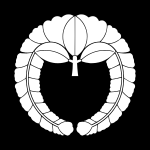The Hokke (藤原北家, Fujiwara Hokke, lit. northern house of Fujiwara) was cadet branch of the Fujiwara clan, the other three being the Nanke, Kyōke and Shikike. The Hokke were the de facto rulers of Japan through their hereditary position as imperial regents (Sesshō and Kampaku). In the Kamakura period, it split into the Five regent houses, who continued to monopolize the regency from the 12th century until 1868. After the Meiji Restoration, these houses were appointed Prince in the new hereditary peerage.
| Fujiwara Hokke 藤原北家 | |
|---|---|
 Mon: Sagarifuji | |
| Parent house | Fujiwara clan |
| Titles | Various |
| Founder | Fujiwara no Fusasaki |
| Founding year | 8th century |
| Cadet branches | |
History edit
The Hokke was founded by Fujiwara no Fusasaki,[1] the second son of Fujiwara no Fuhito, in the Heian period.[2] Fusasaki had three brothers: Muchimaro, Maro and Umakai, and these four brothers are known for having established the "four houses" of the Fujiwara; the Hokke, Nanke, Kyōke and Shikike.[3]
During the time of Fujiwara no Fuyutsugu, the Hokke became prosperous after Fuyutsugu was appointed kurōdo-no-tō (Head Chamberlain). His son Fujiwara no Yoshifusa became the first sesshō (regent in the place of a child Emperor), and his son, Fujiwara no Mototsune, became kampaku (regent in the place of an adult Emperor). After that, members of the Hokke continued to have a strong relationship with the Imperial Family by marrying Hokke daughters to the emperors. This allowed them to exclude other families and monopolize the regent position.[2]
The Hokke prospered during the time of Fujiwara no Michinaga and Yorimichi. In the Kamakura period, Hokke split into the Five regent houses, Konoe, Takatsukasa, Kujō, Ichijō, and Nijō.[2] These families continued to monopolize the regency until the Meiji Restoration in 1868. When the regency was abolished, a new hereditary peerage (kazoku) was established, and these houses were all appointed as Duke.[4]
Notable members edit
- Murasaki Shikibu
- Fujiwara no Teika
- Fujiwara no Michinaga
- Fujiwara no Fuyutsugu
- Fujiwara no Yoshifusa
- Fujiwara no Mototsune
- Fujiwara no Tokihira
- Fujiwara no Atsutada
- Fujiwara no Sukemasa
- Fujiwara no Kintō
- Fujiwara no Kiyosuke
- Lady Ise
- Fujiwara no Michitsuna's mother
- Fujiwara no Michimasa
- Fujiwara no Koretada
- Fujiwara no Yoshitaka
- Fujiwara no Yorimichi
- Fujiwara no Yukinari
- Fujiwara no Sanekata
- Fujiwara no Sadayori
- Fujiwara no Ietaka
- Fujiwara no Mototoshi
- Fujiwara no Sadakata
- Fujiwara no Asatada
- Fujiwara no Tadamichi
- Fujiwara no Sadanaga
- Fujiwara no Atsuyori
See also edit
Notes edit
- ^ Nussbaum, Louis-Frédéric et al. (2005). "Fujiwara no Fusasaki" at Japan Encyclopedia, p. 202, p. 202, at Google Books.
- ^ a b c Obunsha Nihonshi jiten ed. 3 旺文社日本史事典 三訂版. Obunsha 旺文社. 2000. 北家. ISBN 9784010353134.
- ^ Brinkley, Frank and Dairoku Kikuchi. (1915). A History of the Japanese People from the Earliest Times to the End of the Meiji Era, p. 203., p. 203, at Google Books; excerpt, "Muchimaro's home, being in the south (nan) of the capital, was called Nan-ke; Fusazaki's, being in the north (hoku), was termed Hoku-ke; Umakai's was spoken of as Shiki-ke, since he presided over the Department of Ceremonies (shiki), and Maro's went by the name of Kyō-ke, this term also having reference to his office."
- ^ Obunsha Nihonshi jiten ed. 3 旺文社日本史事典 三訂版. Obunsha 旺文社. 2000. 五摂家. ISBN 9784010353134.
References edit
- Brinkley, Frank and Dairoku Kikuchi. (1915). A History of the Japanese People from the Earliest Times to the End of the Meiji Era. New York: Encyclopædia Britannica. OCLC 413099
- Nussbaum, Louis-Frédéric and Käthe Roth. (2005). Japan Encyclopedia. Cambridge: Harvard University Press. ISBN 978-0-674-01753-5; OCLC 58053128